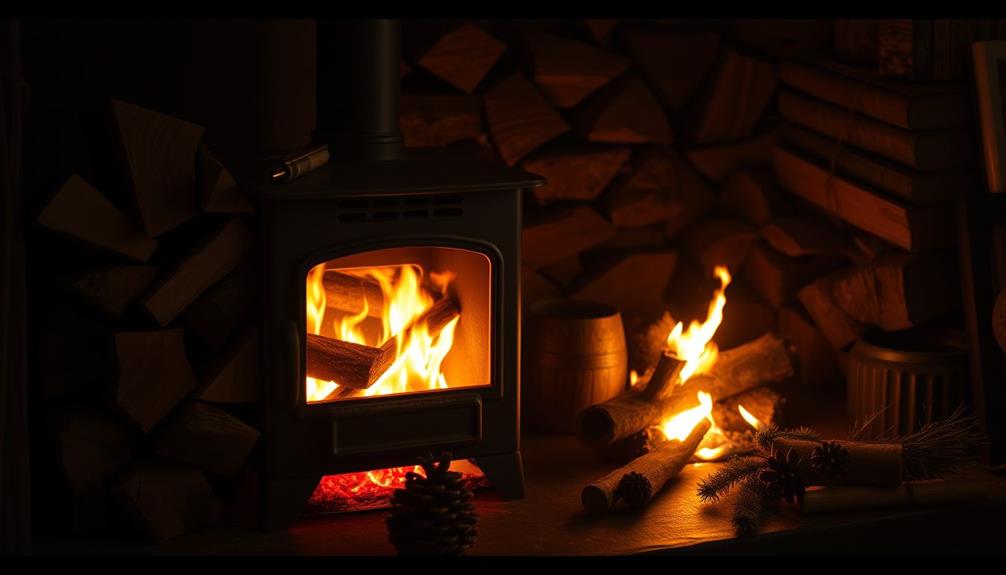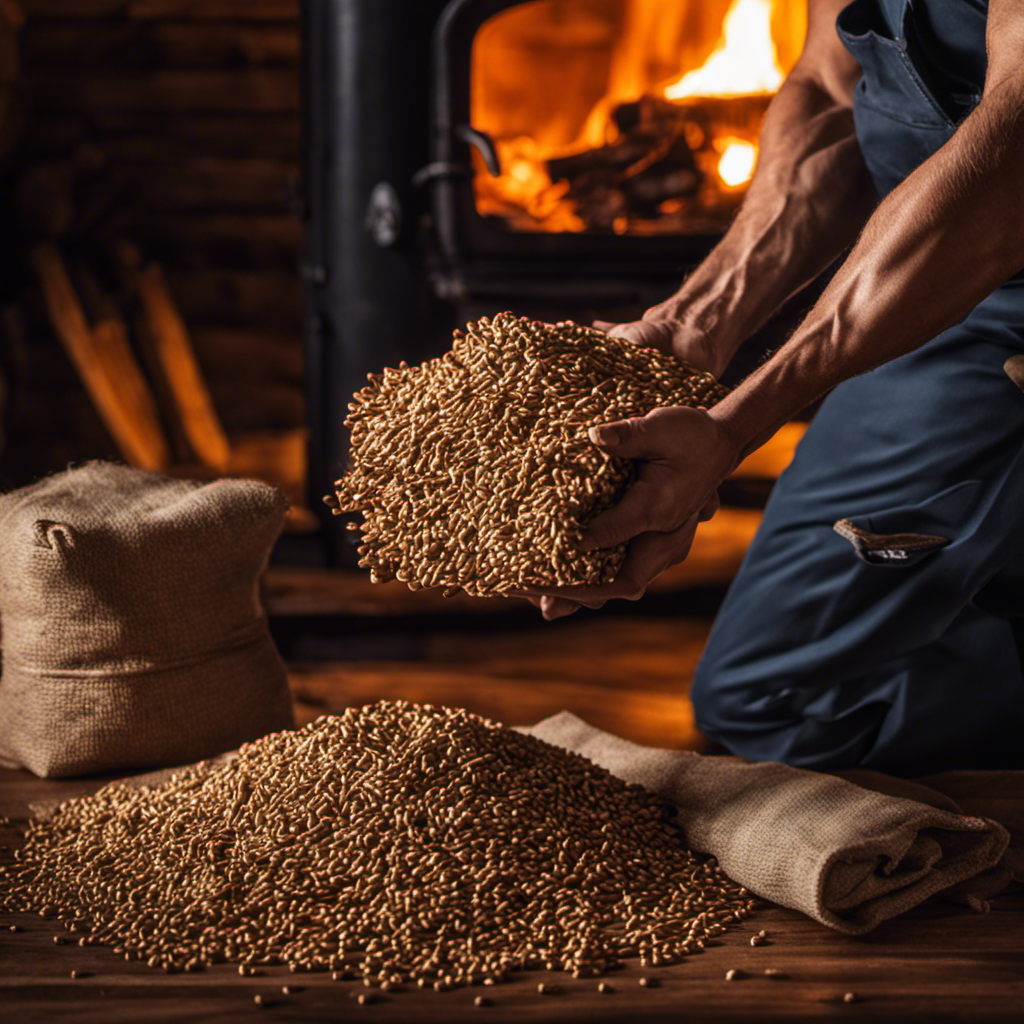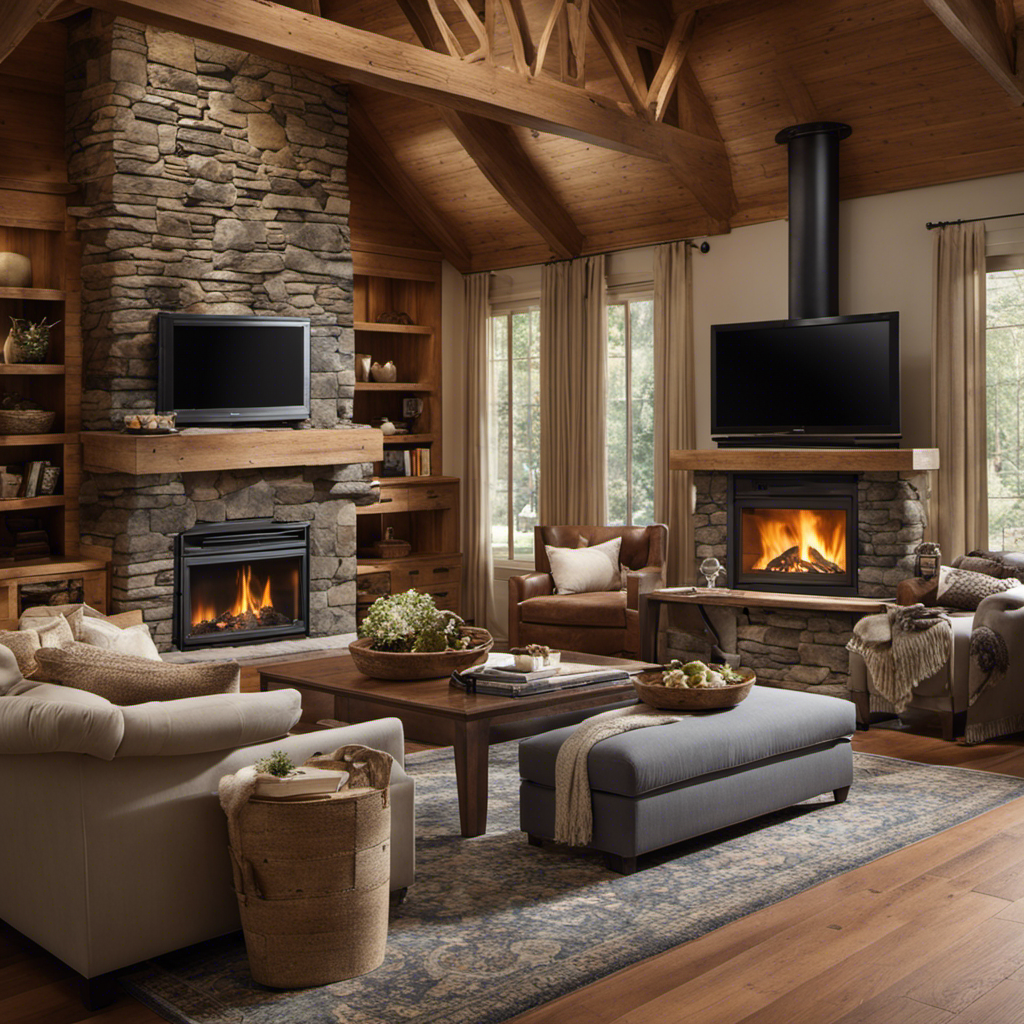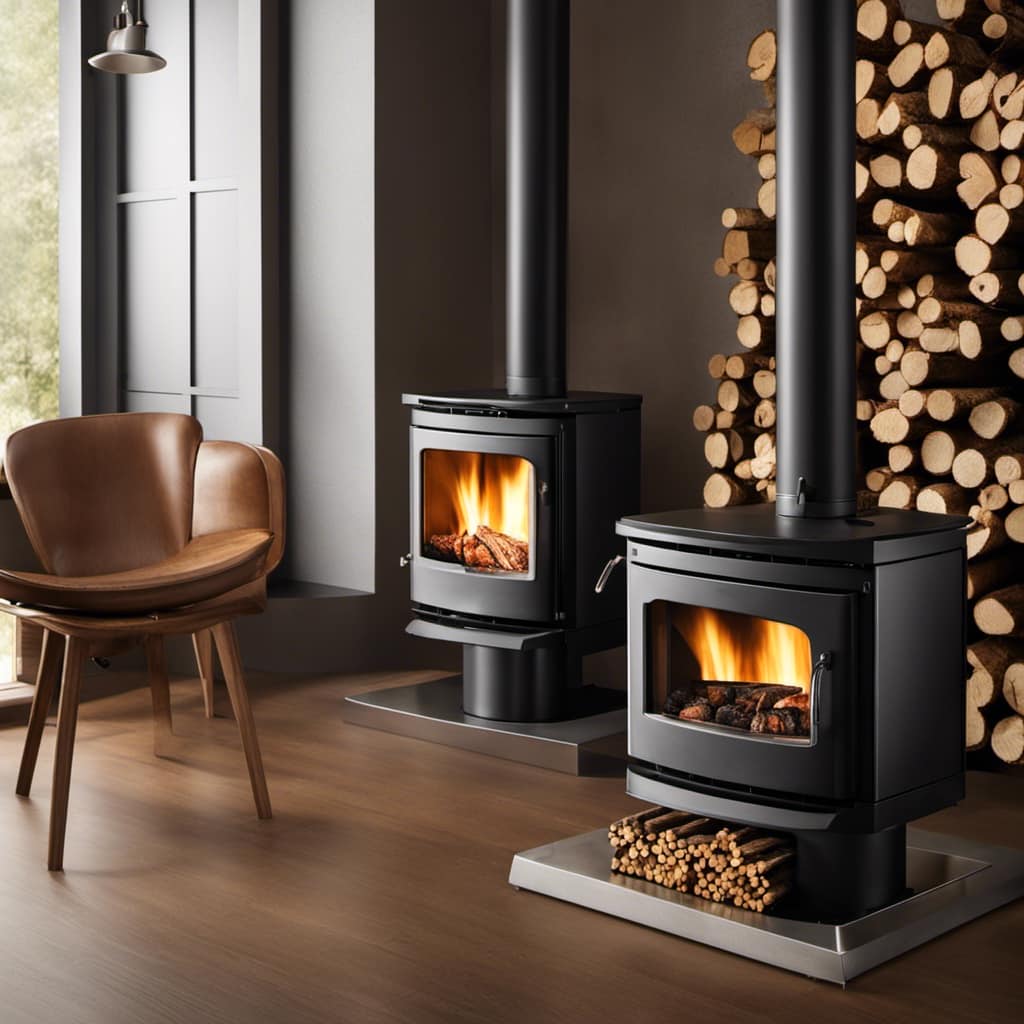
For safety and optimal performance, it is essential to ensure the correct spacing is maintained for a wood stove with a heat shield.
As someone who has installed and used wood stoves with heat shields for years, I understand the importance of following clearance requirements.
In this article, I will provide you with the recommended clearance distances, factors to consider, and tips for ensuring the safety and efficiency of your wood stove.
Let’s dive in and find out everything you need to know about wood stove clearances with heat shields.
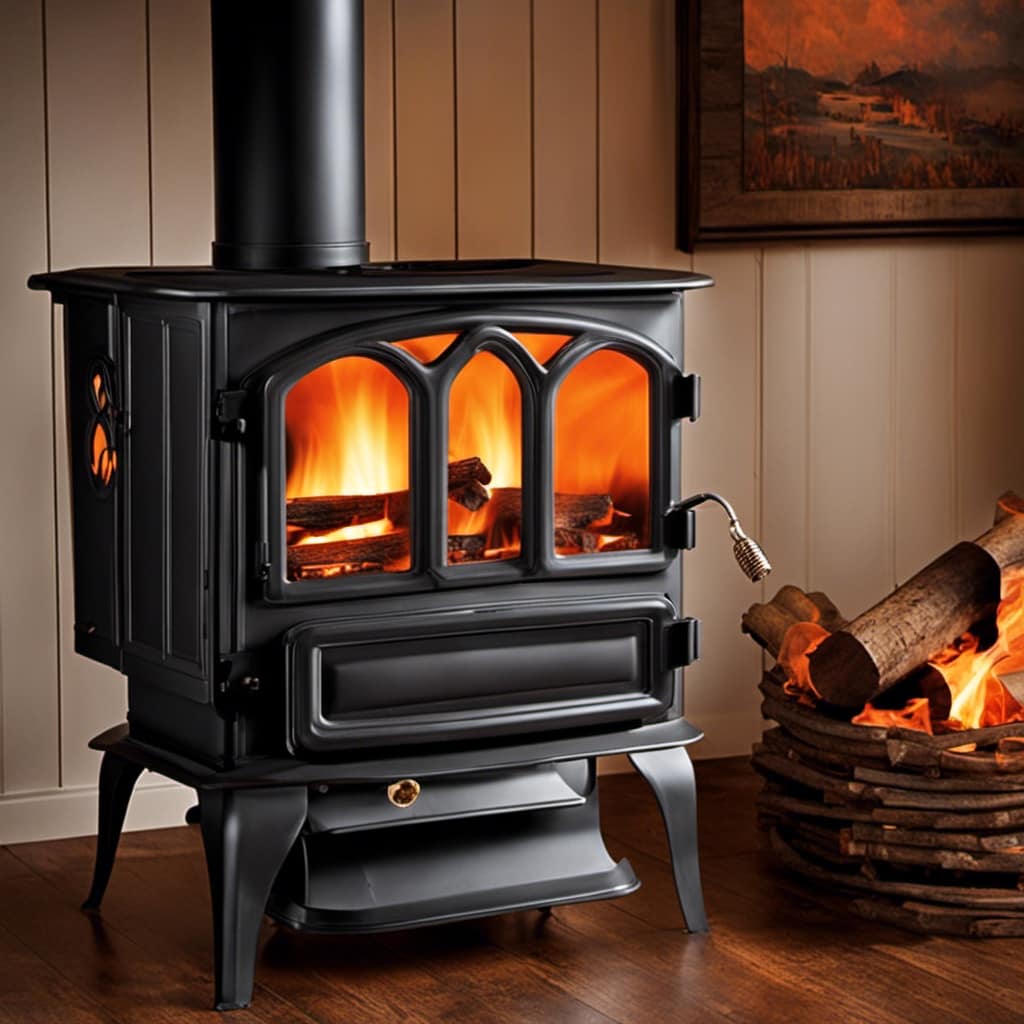
Key Takeaways
- Clearance regulations ensure safety and optimal performance of wood stoves.
- Heat shields reduce clearance requirements between the stove and combustible materials.
- Clearance distances vary based on stove type and manufacturer’s recommendations.
- Adhering to recommended clearance guidelines minimizes fire hazards and maximizes the stove’s performance.
Importance of Clearance for Wood Stoves With Heat Shields
I can’t stress enough the importance of clearance for wood stoves with heat shields.
Clearance regulations are in place for a reason – to ensure the safety and optimal performance of your wood stove. Heat shield effectiveness plays a crucial role in maintaining the required clearance distances.
A heat shield is designed to reduce the surface temperature of the wall behind the stove, allowing for a reduced clearance requirement. This is especially important in small spaces or areas with limited room for installation. The heat shield acts as a barrier, protecting nearby combustible materials from the intense heat emitted by the stove.
Understanding clearance requirements for wood stoves is essential to prevent fire hazards and maintain a safe environment. Now, let’s delve deeper into the specifics of these clearance regulations.

Understanding Clearance Requirements for Wood Stoves
To properly install a wood stove, it’s essential to understand and adhere to the clearance requirements, as well as ensure proper ventilation. The clearance requirements refer to the minimum distance that must be maintained between the wood stove and surrounding combustible materials. These guidelines are crucial for the safety and efficiency of the wood stove.
Here are some key points to consider regarding clearance requirements:
- The specific clearance distances may vary depending on the type of wood stove and the manufacturer’s recommendations.
- Clearance requirements typically include distances for the back, sides, and front of the stove.
- Non-combustible materials, such as bricks or tiles, can be used to reduce the clearance distances.
- Obstructions, such as furniture or curtains, should be kept away from the stove to maintain proper clearance.
- It’s important to regularly inspect and maintain the clearance distances to prevent any fire hazards.
Understanding and following these clearance requirements is essential for the safe installation and operation of a wood stove.
Now, let’s explore the recommended clearance distances for wood stoves with heat shields.

Recommended Clearance Distances for Wood Stoves With Heat Shields
The recommended clearance distances for wood stoves with heat shields depend on the specific model and manufacturer’s guidelines. When it comes to installing a wood stove with a heat shield, it’s crucial to follow the recommended distances to ensure safety and heat shield effectiveness.
These recommended distances are determined by the stove’s design and the manufacturer’s testing. The purpose of a heat shield is to reduce the clearance requirements between the stove and combustible materials, such as walls or furniture. By creating a barrier that deflects heat away from these materials, heat shields can significantly decrease the risk of fire hazards.
It’s important to consult the stove’s manual or contact the manufacturer to get accurate information on the recommended distances for your specific model. By adhering to these guidelines, you can ensure the optimal performance and safety of your wood stove with a heat shield.
Factors to Consider When Determining Clearance for Wood Stoves
One important factor to consider when determining clearance for wood stoves is the distance required between the stove and combustible materials. This clearance is crucial to ensure the safety and efficiency of the wood stove.
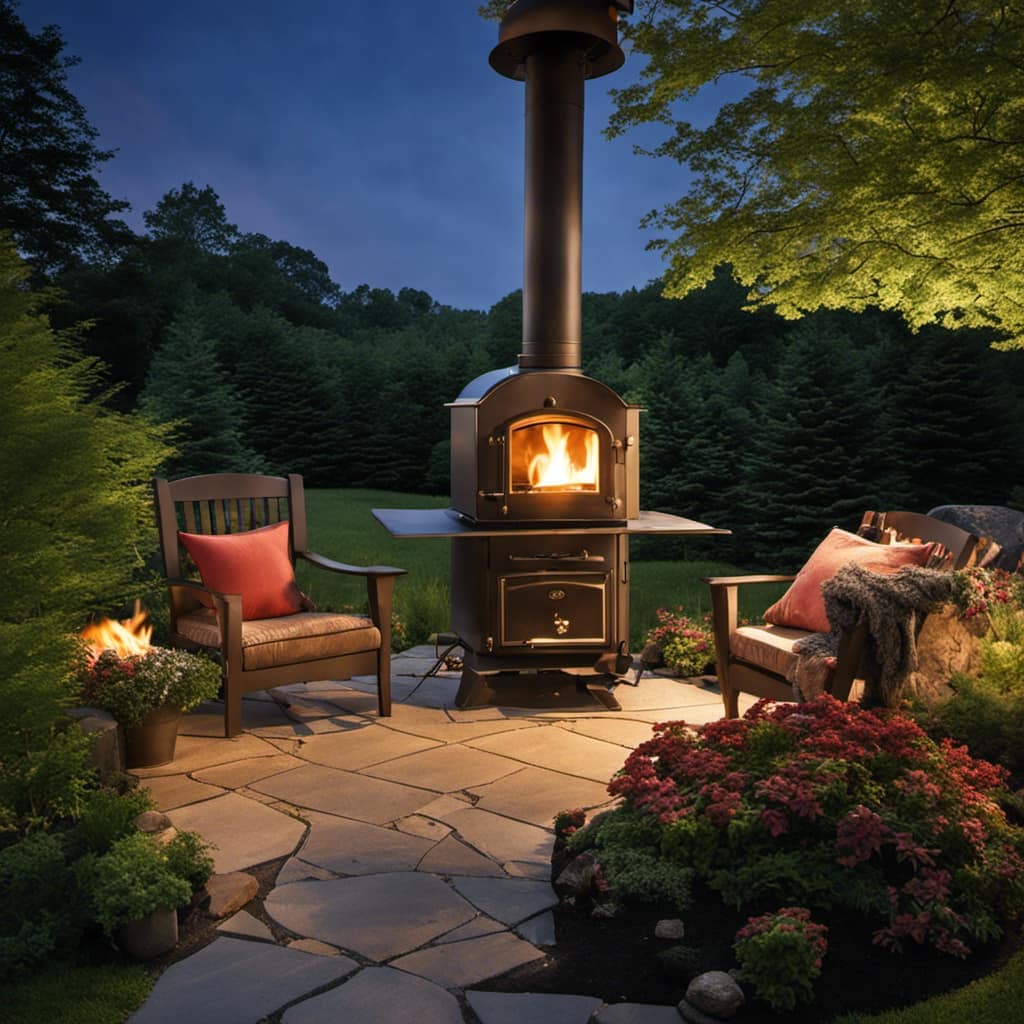
Factors that influence the required clearance include:
-
Type of wood stove: Different types of wood stoves have different clearance requirements. For example, a freestanding wood stove may have different clearance requirements compared to a fireplace insert.
-
Heat output: The heat output of the wood stove is also a factor in determining the required clearance. A wood stove with higher heat output may require a larger clearance distance to prevent overheating of combustible materials.
-
Shielding: The use of heat shields can help reduce the required clearance distance. Heat shields can be installed on walls or floors near the wood stove to provide additional protection.

-
Building codes: Local building codes and regulations may specify minimum clearance requirements for wood stoves. It’s important to consult these codes when determining the appropriate clearance distance.
-
Manufacturer’s recommendations: Finally, it’s essential to follow the manufacturer’s recommendations for clearance. The manufacturer will provide specific guidelines for the safe and efficient operation of the wood stove.
Ensuring Safety and Efficiency With Clearance for Wood Stoves
I can ensure both safety and efficiency by following the recommended clearance guidelines for my wood stove. It is crucial to consider the distance between the stove and combustible materials to prevent potential fire hazards. By adhering to these guidelines, I can minimize the risk of accidents and maximize the stove’s performance.
To provide a clear understanding, let’s take a look at the recommended clearance guidelines for a wood stove with a heat shield:

| Distance from Stove to | Clearance Required | Clearance with Heat Shield |
|---|---|---|
| Combustible Walls | 36 inches | 12 inches |
| Non-Combustible Walls | 18 inches | 6 inches |
| Ceiling | 36 inches | 18 inches |
Frequently Asked Questions
What Are the Potential Dangers of Not Following the Recommended Clearance Distances for Wood Stoves With Heat Shields?
Not following recommended clearance distances for wood stoves with heat shields can lead to potential dangers. Proper installation and maintenance are crucial to prevent fire hazards. Using a heat shield improves energy efficiency and reduces risks.
Are There Any Specific Building Codes or Regulations That Dictate the Clearance Requirements for Wood Stoves With Heat Shields?
Building code requirements and safety regulations dictate the clearance requirements for wood stoves with heat shields. These regulations ensure proper ventilation and reduce the risk of fire hazards, protecting both the occupants and the structure of the building.
Can I Install a Wood Stove With a Heat Shield in a Mobile Home or Rv?
Sure, I can install a wood stove with a heat shield in a mobile home or RV. The materials for the heat shield are important, as is regular inspection to ensure safety.
What Types of Materials Are Commonly Used for Heat Shields for Wood Stoves?
For a wood stove with a heat shield, the clearance requirements depend on the specific model and manufacturer’s instructions. It’s important to follow these guidelines to ensure safe installation and operation.

How Often Should I Have My Wood Stove and Heat Shield Inspected to Ensure Safety and Efficiency?
I make sure to have my wood stove and heat shield inspected regularly for safety and efficiency. Signs of heat shield damage include warping, discoloration, or cracks. It’s important to stay on top of wood stove maintenance for peace of mind.
Conclusion
In conclusion, ensuring proper clearance for wood stoves with heat shields is crucial for both safety and efficiency. By understanding and adhering to recommended clearance distances, homeowners can prevent potential hazards and maximize the performance of their wood stoves.
Considering factors such as the type of heat shield and the surrounding materials is essential in determining the ideal clearance. By following these guidelines, individuals can enjoy the warmth and comfort of their wood stoves with peace of mind.
As the saying goes, ‘Better safe than sorry!’

Growing up surrounded by the vast beauty of nature, Sierra was always drawn to the call of the wild. While others sought the comfort of the familiar, she ventured out, embracing the unpredictable and finding stories in the heartbeat of nature.
At the epicenter of every remarkable venture lies a dynamic team—a fusion of diverse talents, visions, and passions. The essence of Best Small Wood Stoves is crafted and refined by such a trio: Sierra, Logan, and Terra. Their collective expertise has transformed the platform into a leading authority on small wood stoves, radiating warmth and knowledge in equal measure.




